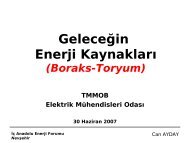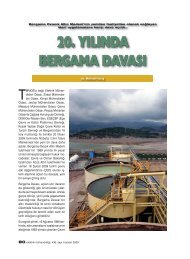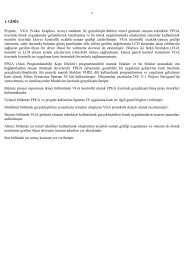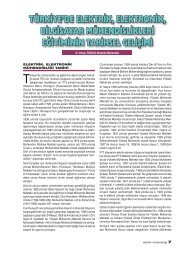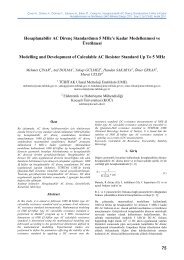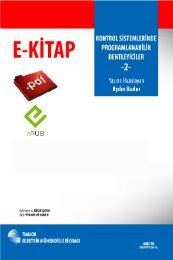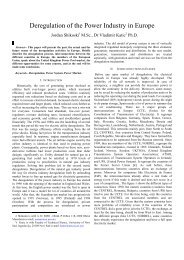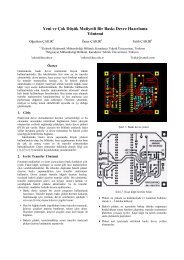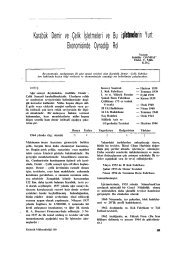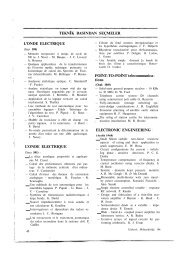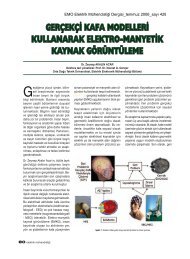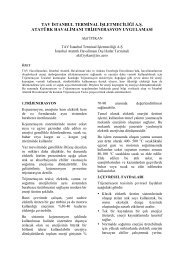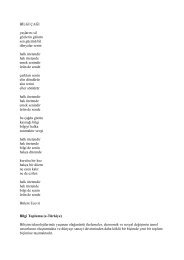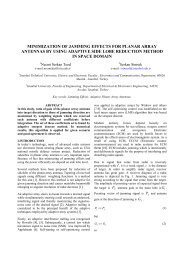POTENTIALITY OF CHANNEL ASSIGNMENT FOR ... - emo
POTENTIALITY OF CHANNEL ASSIGNMENT FOR ... - emo
POTENTIALITY OF CHANNEL ASSIGNMENT FOR ... - emo
You also want an ePaper? Increase the reach of your titles
YUMPU automatically turns print PDFs into web optimized ePapers that Google loves.
''ELECO'99<br />
INTERNATIONAL CONFERENCE<br />
ON ELECTRICAL AND ELECTR.ONICS<br />
ENGINEERING"<br />
to^, =r, ^=1,M. (l)<br />
The presented model is adequate to<br />
frequency reuse in cellular<br />
communication systems []. The C/R<br />
value for rz-th user under the condition<br />
that it occupies the z-th frequency is<br />
(n) O<br />
CIR(mV)=- P;;u'<br />
, (2)<br />
Loup(tQr * 1^<br />
k=l<br />
ktn<br />
where pP is the power transient<br />
coefficient from /+h user's transmitter<br />
to the rn-th user's receiver at the n-th<br />
frequency, Q, is the power of /-th<br />
transmitter, P^ is the power of<br />
environment noise for the m-th user<br />
receiver at the n-th frequency. The<br />
presence of variables tno in the<br />
denominator shows what &-th user<br />
transmits (or not) at the same n-th<br />
frequency and consequently, interferes<br />
with the rz-th one.<br />
The value showing suitability of the<br />
quality for the rz-th user under the<br />
given z is q(n4n)=ulcn(nln)-n:l<br />
with z(.r) is unit step function. Since<br />
a* arrd q(4")are equal to I or 0, the<br />
expression for number of users with<br />
suitable communication quality can be<br />
written as follows:<br />
MN<br />
s =2Zo^q(4,) =<br />
m=l n=l<br />
MN<br />
LLa*u<br />
n=l n=l<br />
[an(,,|")<br />
-h:)<br />
(3)<br />
The natural objective is to ma:cimize<br />
the value ,S and thus the procedure of<br />
optimal allocation consists in solution<br />
of the extremal problem<br />
S + max = S* under the conditions<br />
(l). The result of the solution will be a<br />
vector, =<br />
lo,-,f , supplying maximum<br />
to ^S and yielding the allocation<br />
algorithm. The probability that one<br />
user obtains the suitable<br />
communication quality is<br />
\ = E(S^*)f M with E(o) be the<br />
symbol of mathematical expectation,<br />
and we will accept this value as the'<br />
figure-of-merit for performance of the<br />
allocation procedure.<br />
Performance: We treated the<br />
performances for the case of<br />
homogeneity, that is, for all m, n,<br />
Q,, = Q, p and Fin, tro average values<br />
of fr!,ll and rrfl correspondingly<br />
(k *<br />
m), 1,=P , i/i,^,=d,<br />
andH=iQlP.The values d ail, H<br />
are the average signal-to-interference<br />
(^SIR) and signal-to-noise (,SIVR) ratios<br />
for one user. The obtained algorithm is<br />
generated by the extremal problem,<br />
belonging to .l/P-complete ones with<br />
essential difficulties for the solution.<br />
Owing to .l/P-completeness and since<br />
our aim does not consist in<br />
surmounting of computation<br />
difficulties, we restricted ourselves to<br />
simple exploration example solved by<br />
simulation. The simulation was<br />
performed for the case of log-normal<br />
shadowing (slow) fading, averaged<br />
over fast fading [2]. The results of the<br />
simulation are presented in Fig l.<br />
III. TEE SUBOPTIMAL ALLOCATION<br />
PROCEDTJRE<br />
Since the optimal procedure is .l/Pcomplete<br />
and hardly feasible<br />
practically we introduce the following<br />
heuristical allocation procedure<br />
a= {a^: a,^ = l,a^r = o for n such<br />
that pf) > pl* ;",k . {t,"}, k * n}' ,<br />
(4)<br />
According to the procedure each user<br />
occupies its best frequency regardless<br />
of pretensions and intentions of other



